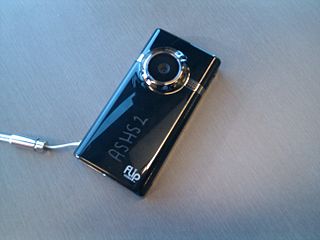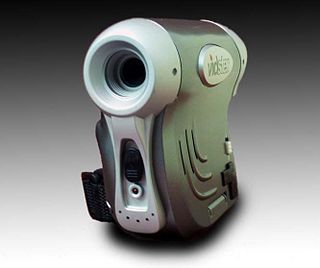Digital video is an electronic representation of moving visual images (video) in the form of encoded digital data. This is in contrast to analog video, which represents moving visual images with analog signals. Digital video comprises a series of digital images displayed in rapid succession.

VHS is a standard for consumer-level analog video recording on tape cassettes. Developed by Victor Company of Japan (JVC) in the early 1970s, it was released in Japan on September 9, 1976, and in the United States on August 23, 1977.

DV is a format for storing digital videos. It was launched in 1995 with joint efforts of leading producers of video camera recorders. It is the foundation of the MiniDV format.

S-VHS (スーパー・ヴィエイチエス), the common initialism for Super VHS, is an improved version of the VHS standard for consumer-level video recording. Victor Company of Japan introduced S-VHS in Japan in April 1987 with their JVC-branded HR-S7000 VCR, and in certain overseas markets soon afterward. Shortly, later in the same year of 1987, first S-VHS VCR models from other competitors included Hitachi VT-2700A, Mitsubishi HS-423UR, Panasonic PV-S4764, and Toshiba SV-950.

Betamax is a consumer-level analog-recording and cassette format of magnetic tape for video, commonly known as a video cassette recorder. It was developed by Sony and was released in Japan on May 10, 1975. The first Betamax device introduced in the United States was the LV-1901 console, which included a 19-inch (48 cm) color monitor, and appeared in stores in early November 1975. The cassettes contain 0.50-inch-wide (12.7 mm) videotape in a design similar to that of the earlier, professional 0.75-inch-wide (19 mm), U-matic format. Betamax is obsolete, having lost the videotape format war to VHS. Despite this, Betamax recorders were not discontinued until August 2002. Betamax cassettes were available until March 2016, when Sony stopped making and selling them, alongside MicroMV.
Digital8 is a consumer digital recording videocassette for camcorders based on the 8 mm video format developed by Sony, and introduced in 1999.

D-1 or 4:2:2 Component Digital is a SMPTE digital recording video standard, introduced in 1986 through efforts by SMPTE engineering committees. It started as a Sony and Bosch - BTS product and was the first major professional digital video format. SMPTE standardized the format within ITU-R 601, also known as Rec. 601, which was derived from SMPTE 125M and EBU 3246-E standards.

A camcorder is an electronic device originally combining a video camera and a videocassette recorder.

Betacam is a family of half-inch professional videocassette products developed by Sony in 1982. In colloquial use, "Betacam" singly is often used to refer to a Betacam camcorder, a Betacam tape, a Betacam video recorder or the format itself.

The video camera is a camera used for electronic motion picture acquisition, initially developed for the television industry but now common in other applications as well.

The 8mm video format refers informally to three related videocassette formats for the NTSC and PAL/SECAM television systems. These are the original Video8 format and its improved successor Hi8, as well as a more recent digital recording format known as Digital8.

HDV is a format for recording of high-definition video on DV cassette tape. The format was originally developed by JVC and supported by Sony, Canon, and Sharp. The four companies formed the HDV Consortium in September 2003.

VHS-C is the compact VHS videocassette format, introduced by Victor Company of Japan (JVC) in 1982, and used primarily for consumer-grade compact analog recording camcorders. The format is based on the same video tape as is used in VHS, and can be played back in a standard VHS VCR with an adapter. Though quite inexpensive, the format is largely obsolete even as a consumer standard and has been replaced in the marketplace by digital video formats, which have smaller form factors.

Sadie T. Benning is an American artist, who has worked primarily in video, painting, drawing, sculpture, photography and sound. Benning creates experimental films and explores a variety of themes including surveillance, gender, ambiguity, transgression, play, intimacy, and identity. They became a known artist as a teenager, with their short films made with a PixelVision camera that have been described as, "video diaries". Landmarks, the public art program of The University of Texas at Austin, exhibited Girl Power (1993) and archived an essay dedicated to Benning and their work on Landmark's website

P2 is a professional digital recording solid-state memory storage media format introduced by Panasonic in 2004, and especially tailored to electronic news-gathering (ENG) applications. It features tapeless (non-linear) recording of DV, DVCPRO, DVCPRO25, DVCPRO50, DVCPRO-HD, or AVC-Intra streams on a solid-state flash memory. The P2 card is essentially a RAID of Secure Digital (SD) memory cards with an LSI controller tightly packaged in a die-cast PC Card enclosure, so data transfer rate increases as memory capacity increases. The system includes cameras, decks as drop-in replacements for videocassette recorders (VCR), and a special 5.25-inch computer drive for random-access integration with non-linear editing systems (NLE). The cards can also be used directly where a PC card (PCMCIA) slot is available, as in most older notebook computers, as a normal hard disk drive, although a custom software driver must first be loaded.
Sony produces professional, consumer, and prosumer camcorders.

The Mattel Vidster is a digital tapeless camcorder that was marketed as a children's toy. It features a 1.1-inch (28 mm) LCD display, a 2x digital zoom, and records into AVI 320x240 video files encoded with the M-JPEG codec at 15 frames per second, with 22 kHz monaural sound. It also takes still photos with 1.3 megapixel resolution.
The Sony DCR-VX1000 was a DV tape camcorder released by Sony in 1995, replaced by the DCR-VX2000 in 2000 and the DCR-VX2100 in mid 2003.













